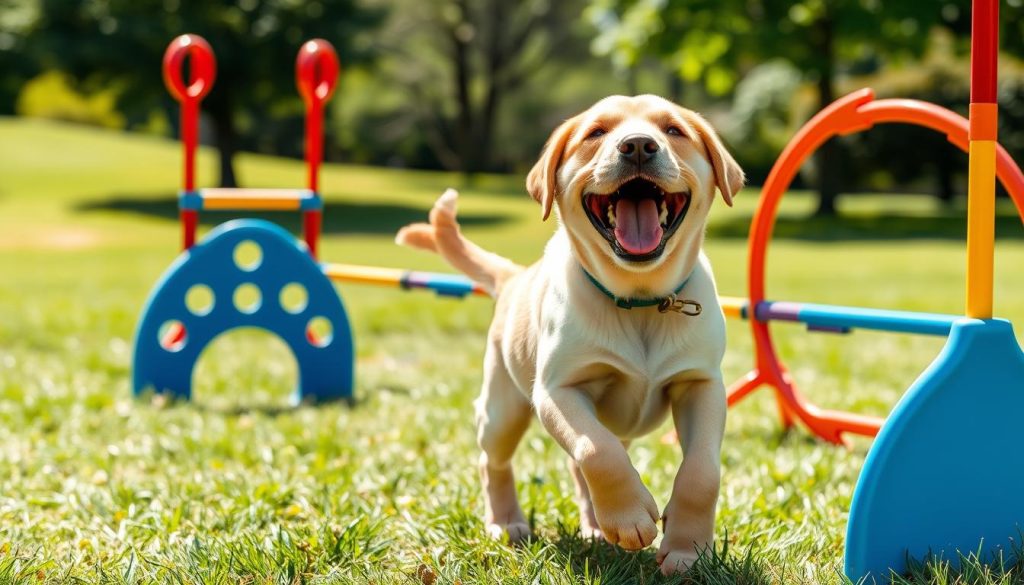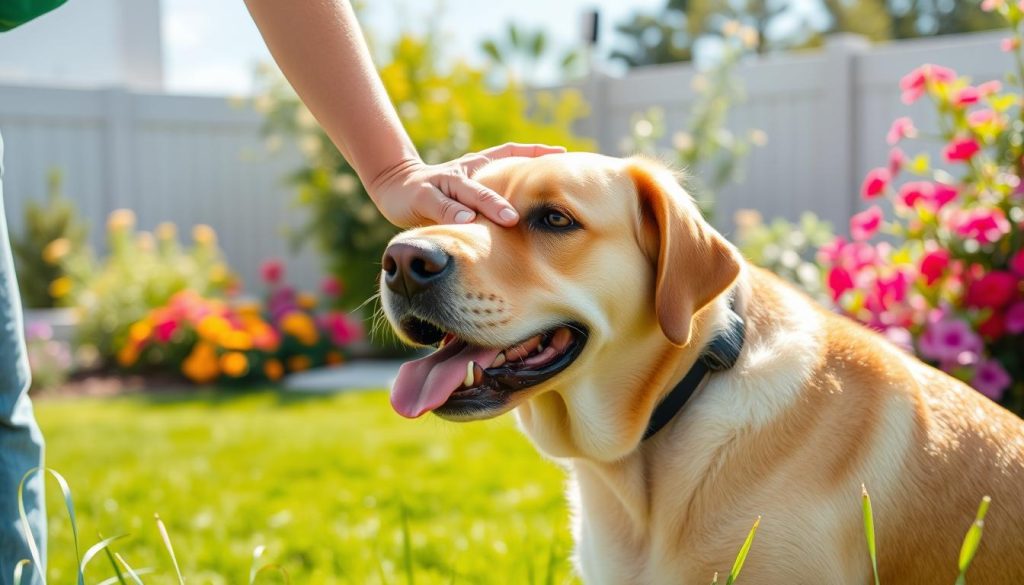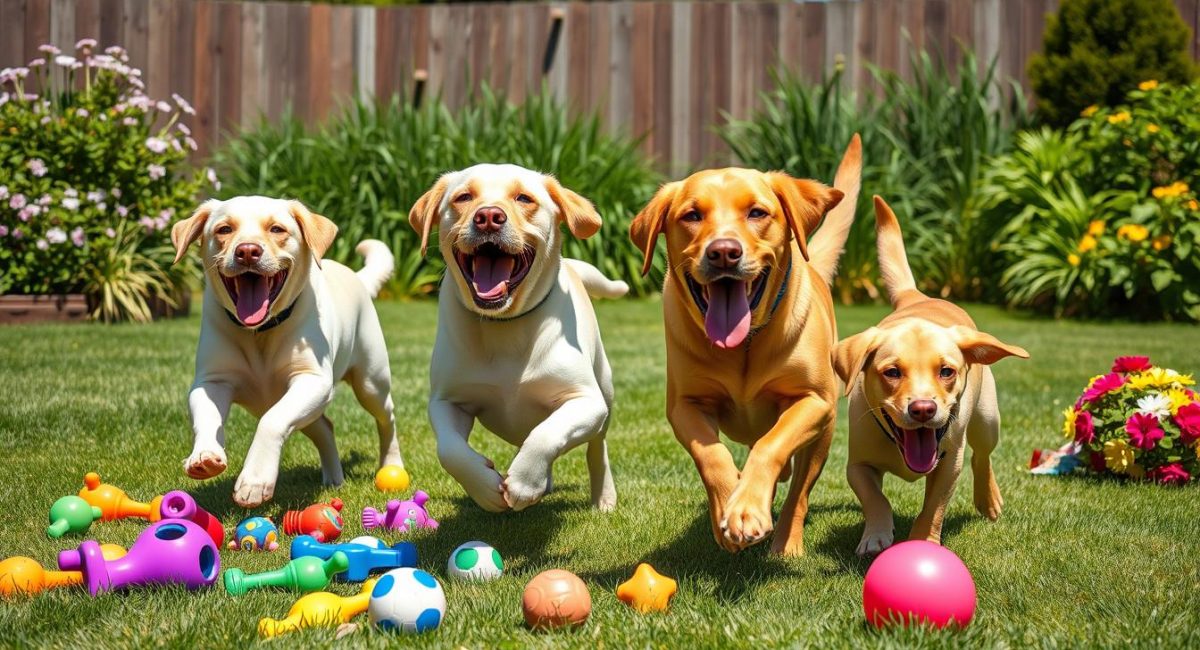Labrador Retrievers: Great Family Dogs for Kids
Did you know Labrador Retrievers are a top dog breed in the UK1? They are known for being loving and loyal, perfect for families with kids2. Their high energy fits well with many families’ active lives3.
Key Takeaways:
- Labrador Retrievers are one of the most popular dog breeds in the UK.
- Labradors are known for their high energy levels, making them excellent companions for active families.
- Labrador Retrievers possess a friendly and even-tempered nature, well-suited for interactions with children of all ages.
- Labradors quickly learn to be gentle around smaller children, showcasing their adaptability and understanding.
- Labrador Retrievers are popular family dogs due to their trainability, patience, and love for playtime.
The Labrador: The Ultimate Family Companion
Key Qualities That Make Labradors Ideal for Families
Labradors are perfect for families. They are loyal, patient, and full of energy. These smart dogs love to please and are great with active kids4.
Labradors are among the top family dog choices. They are easy to train because they are so smart and eager to please4. Their high energy and playful nature make them perfect playmates for kids4.
Labradors are known for their loyalty and protective nature. They are gentle and patient with children, making them a great choice for families4. They can adapt to any home, big or small4.
Labradors are the best family dogs. They are friendly, easy to train, and full of energy. They give their families endless love and loyalty4.
“Labradors are the perfect blend of playfulness, patience, and protectiveness – the ideal dog for families with children.”
Getting to Know the Labrador Breed
Thinking about getting a Labrador retriever as a family pet? It’s key to know the breed’s characteristics. Labradors are known for their great temperament. But, knowing their size, lifespan, grooming needs, health issues, and exercise needs gives a clearer picture of what to expect5.
Labradors are usually 21.5 to 24.5 inches tall and weigh 55 to 80 pounds. Males are a bit bigger than females5. They live for 10 to 12 years, which is important for families with young kids.
Grooming is not too hard for Labradors. But, their thick coat sheds a lot. So, they need regular brushing to keep loose hair under control5. They are generally sturdy but can get hip dysplasia, heart problems, and eye issues5.
Labradors are very energetic and need lots of exercise. This can be walks, playtime, swimming, or agility training5. They need this to stay physically and mentally healthy. Without enough exercise, they might act out.
| Labrador Characteristics | Details |
|---|---|
| Size | Average height: 21.5 – 24.5 inches Average weight: 55 – 80 pounds Males slightly larger than females |
| Lifespan | 10 – 12 years |
| Grooming Needs | Thick, double-coat that sheds Regular brushing required |
| Health Issues | Hip dysplasia, heart problems, eye issues |
| Exercise Requirements | Significant daily exercise needed Walking, swimming, agility training |
In summary, knowing about a Labrador’s size, lifespan, grooming, health, and exercise needs is crucial for families5. With proper care and commitment, Labradors can be wonderful, loyal pets for families with kids6.
Are Labrador Retrievers good with kids?
Why Labradors Make Excellent Family Dogs
Labradors are top picks for families with kids. They are patient, gentle, and tolerant, making them great friends for young ones7. They interact well with babies, toddlers, and young children, showing kindness and care7. Having a Labrador in the home teaches kids about gentleness, patience, and love.
7 Growing up with a Labrador can help kids feel more comfortable around dogs. Labs can be playmates during the day and offer comfort at night, people say.
7 Many believe Labradors are the best dogs for raising children. They are good with kids and other pets, but it’s key to supervise and train them for safe play.
| Characteristic | Description |
|---|---|
| Size | 8 Labrador Retrievers are usually 21.5 to 24.5 inches tall and weigh 55 to 80 pounds. |
| Lifespan | 8 With proper care, Labradors can live up to 12 years9. They typically live between 10 to 14 years. |
| Temperament | 9 Labs are friendly, outgoing, and gentle, making them perfect for families7. English Labradors are especially good with young children. |
| Health Concerns | 8 Labradors can face issues like hip and elbow dysplasia, eye problems, bloat, and obesity9. They are generally healthy but can have genetic problems like hip dysplasia and eye issues. |
| Popularity | 9 In 2023, the French Bulldog took the top spot from the Labrador Retriever, ending their 31-year reign8. Despite this, Labradors remain a favourite in the US. |
“Labradors can serve as play companions for children during the day and provide a sense of security at night, according to anecdotal evidence.”
9 Labradors are smart and easy to train, often working as search and rescue dogs, therapy dogs, and assistance dogs. Their patient temperament, gentle disposition, and tolerance for activity make them excellent family pets.
Preparing Your Home for a Labrador Puppy
Welcoming a Labrador puppy into your home requires making it safe and suitable for their energy. You need to puppy-proof your home, provide the right toys, and set routines for them to thrive10.
First, find and secure any dangers in your home. Labradors are curious and might be drawn to harmful items like antifreeze or chocolate10. Keep these items away and use dog-repellent sprays on things you can’t hide10.
Labradors love water, so make sure they can’t get to pools or other water without you10. Give them a play area with lots of toys and activities to keep them busy11.
Having a regular routine for meals, walks, and potty breaks will make your puppy feel safe12. Make time for walks, play, and training to help them adjust well11.
By preparing your home and creating a caring space, you’ll help your Labrador puppy settle in well101112.
Training and Socializing Your Labrador
Raising a well-behaved Labrador Retriever starts with early training and socialization. Labradors are known for their friendly and eager-to-please nature. But, their energetic temperament needs consistent training to keep their enthusiasm positive.
Essential Training Tips for Families
Enrolling your Labrador puppy in obedience classes is a great idea. It teaches basic commands and good manners. It also provides socialisation opportunities with others13.
Using positive reinforcement, like treats and praise, helps your Labrador learn quickly13. It’s also important to set clear boundaries and rules in the household. This helps your Labrador understand what’s expected of them as a family pet13.
- Start obedience training at around 4 months of age13
- Teach your Labrador to swim from around 3 months13
- Avoid allowing puppies to use stairs until they’re at least 4 months old13
By consistently reinforcing good behaviour and providing socialization, your Labrador will become a well-adjusted, family-friendly companion.

“Early socialization is crucial for Labrador Retrievers to develop into confident and well-rounded adults.”14
Proper socialization benefits the dog and helps children feel safe around the Labrador14. Building a strong, trusting relationship through playtime and treats is key1413.
Exercising and Engaging Your Labrador
Labrador Retrievers are very energetic and need lots of exercise and mental games to be happy15. They can live up to 14 years with the right care15. It’s important to keep them active with walks, fetch, swimming, and fun toys.
Labradors love swimming and doing agility training15. Males are 22.5 to 24.5 inches tall, and females are 21.5 to 23.5 inches15. When you can’t play, give them toys and puzzles to keep them busy.
15 Adult males weigh 65 to 80 pounds, and females weigh 55 to 70 pounds15. They are the most popular breed in the US, UK, and Canada for their friendly nature15. It’s key to meet their exercise needs to keep them well-behaved.
| Exercise Guideline for Labrador Puppies | Age | Exercise Duration |
|---|---|---|
| “5-minute rule” | Puppy | 5 minutes per month of age, up to twice a day |
| Alone time | 8-10 weeks | 1-2 hours |
| Alone time | 3-4 months | 2-3 hours |
| Alone time | 5-6 months | 3-4 hours |
| Alone time | 6 months and older | 4-6 hours |
15 The “5-minute rule” is a good guide for exercise15. Puppies shouldn’t be left alone for too long. Children should know when puppies are uncomfortable to interact gently.
“Labradors are a highly energetic breed that require a significant amount of daily exercise and mental stimulation to stay happy and healthy.”
Grooming and Health Care for Your Labrador
Labradors are known for being laidback, but they still need regular grooming and health care16. They don’t need a lot of grooming, but their thick coats shed a bit all year. This means they need weekly brushing to get rid of loose hair16. They also need the occasional bath, regular nail trims, and dental care to stay in top shape.
Labradors can get sick with things like hip dysplasia, elbow dysplasia, obesity, and progressive retinal atrophy16. Taking them to the vet regularly is key. This way, you can catch any health problems early and treat them quickly.
By taking good care of your Labrador, they can live a long, happy life with you17. Labradors live for about 10-12 years17. They make great pets because they are loyal and loving with the right care.
| Grooming Requirement | Frequency |
|---|---|
| Brushing | Weekly |
| Bathing | Occasional |
| Nail Trims | Regular |
| Dental Care | Regular |

“Proper grooming and healthcare are essential for Labradors to thrive as family pets. By staying on top of their needs, you can help ensure your furry friend enjoys a long, healthy, and happy life.”
Common Health Issues in Labradors
Being a responsible Labrador owner means looking after their health17. Regular vet visits and screenings are crucial. They help catch health problems early, so you can treat them fast16. By focusing on grooming and health, you ensure your Labrador lives a long, happy life with you.
Introducing a Labrador Puppy to Children
Building a Positive Relationship
Welcoming a Labrador puppy into a home with kids needs careful planning. It’s important to watch their interactions and set rules for safety18. Teach your kids how to play nicely with the puppy, using praise and treats for good behaviour18.
Start training the puppy to respect kids from the beginning. This way, everyone can enjoy a happy and safe time together18.
With time, patience, and positive feedback, your Labrador and kids will grow close18. The puppy will learn to be gentle, and the kids will learn to be kind18. This early start will help them have a lifelong friendship.
Studies show that kids with dogs are healthier and miss less school19. Teaching kids about respecting dogs can prevent most bites, building trust19.
When introducing a Labrador puppy to kids, always watch them together and set clear rules18. With patience and positive feedback, your puppy and kids will become great friends. They will learn to respect and care for each other18.
Some breeders might not sell Labradors to families with young kids, knowing they need careful introduction18. But with the right care, Labradors can be wonderful family pets. They bring joy, security, and teach valuable lessons to kids of all ages18.
Creating a strong bond between your Labrador and kids is rewarding for everyone18. With the right guidance, your Labrador’s friendly nature makes them great playmates and protectors for your children18.
“It’s estimated that by teaching children about consent with dogs, the vast majority of dog bites can be prevented, creating relationships based on mutual trust.”
- Supervise all interactions between the Labrador puppy and children.
- Teach children how to properly and gently interact with the puppy.
- Reinforce good behaviour with praise and rewards.
- Establish clear rules and expectations around acceptable conduct.
- Be patient, consistent, and use positive reinforcement to build a strong bond.
Conclusion
Labrador Retrievers are the top choice for families, known for their kind hearts, loyalty, and love for kids20. They are perfect playmates for kids, creating a strong bond and lasting friendship20. To make sure your Labrador and kids get along well, prepare your home, train and socialize your puppy, and give them lots of exercise and care21.
Labradors live for 10-12 years, bringing endless love and fun to your home22. They are among the smartest dog breeds, eager to please and easy to train21. This makes them a well-behaved and loving part of your family21.
Labradors are great because they love to play, protect kids, and fit into any family20. Their friendly nature, energy, and loyalty make them the best family dogs21. They promise to bring joy, laughter, and lifelong friendship to homes with kids in the UK212220.
FAQ
Are Labrador Retrievers good with kids?
Yes, Labrador Retrievers are great with kids. They are patient, gentle, and tolerant. This makes them perfect friends for young children.
What are the key qualities that make Labradors ideal for families?
Labradors love being part of a family. They are loyal, patient, and even-tempered. They also have lots of energy and are easy to train. These traits make them excellent family pets.
What should I know about the Labrador breed in terms of size, grooming, and health?
Labradors are medium-sized dogs, standing between 21.5 and 24.5 inches tall. They weigh 55 to 80 pounds and live for 10 to 12 years. They have a thick coat that sheds a lot and needs regular brushing. They can get hip dysplasia, heart problems, and eye issues.
Why are Labradors considered one of the best family dog breeds?
Labradors are great with kids because they are patient and gentle. They also have lots of energy and love to please. Their affectionate nature makes them perfect for family life.
What should I do to prepare my home for a Labrador puppy?
To prepare for a Labrador puppy, puppy-proof your home. Provide the right toys and enrichment. Also, set up a routine for feeding, exercise, and potty training to keep them safe and happy.
How should I train and socialize my Labrador puppy?
Training and socializing your puppy early is crucial. Enroll them in obedience classes and use positive reinforcement. This will help them learn quickly and behave well.
How much exercise do Labradors need?
Labradors need a lot of exercise and mental stimulation. They enjoy walks, fetch, swimming, and interactive toys. This keeps them happy and healthy.
What grooming and health care do Labradors require?
Labradors don’t need a lot of grooming but their coat sheds a lot. They need regular brushing and occasional baths. They also need nail trims and dental care. Regular vet visits are important for their health.
How should I introduce a Labrador puppy to children?
When introducing a puppy to children, supervise their interactions. Teach your kids how to gently play with the puppy. Use praise and rewards to encourage good behaviour and build a safe relationship.
Source Links
- No title found – https://www.akc.org/expert-advice/dog-breeds/best-family-dogs/
- Top 10 Best Family Dog Breeds | Nylabone – https://www.nylabone.com/dog101/10-great-family-dogs
- Best Family Dogs: Top 15 Breeds | James Wellbeloved™ – https://wellbeloved.com/blogs/caring-for-dogs/which-are-the-best-dogs-for-families?srsltid=AfmBOopBsT80cM1H-XqbOp57lxiUzrSlSecWDLxSTgTy0tEmQLySUJVI
- Labradors and Kids: Why They’re the Perfect Family Dog – https://www.barkwithwonder.com/post/labradors-the-perfect-family-dog
- Why Labradors Are the Best Family Dog – https://neaterpets.com/blogs/news/labradors-best-family-dog
- Are Labradors Good Family Pets? – Vet Help Direct – https://vethelpdirect.com/vetblog/2023/08/31/are-labradors-good-family-pets/
- No title found – https://emlabradors.com/2015/04/labbies-and-babies-the-labrador-retriever-and-the-growing-family/
- Labrador Retriever as Family Dogs: Pros & Cons to Consider – https://blog.tryfi.com/labrador-retrievers-family-dogs/
- Labrador Retriever Dog Breed Information & Characteristics – https://dogtime.com/dog-breeds/labrador-retriever
- How to Prepare Your Home for a Labrador Retriever – https://www.dummies.com/article/home-auto-hobbies/pets/dogs/breeds/labrador-retrievers/how-to-prepare-your-home-for-a-labrador-retriever-195950/
- How To Raise & Care For A Lab Puppy (Complete A-Z Step By Step Guide) – https://www.snowypineswhitelabs.com/blog/how-to-raise-care-for-a-labrador-puppy/
- Bringing Home a New Labrador Puppy — Smoky Mountain Labradors – https://www.smokymtnlabrador.com/blog/what-to-do-when-bringing-home-a-new-labrador-puppy
- No title found – https://www.akc.org/expert-advice/training/train-labrador-retriever-puppy-milestone-timeline/
- The Labrador Retriever: Social & Trustworthy For Children – https://www.mydoggifts.com/dog-breeds/labrador-retriever/?lang=en
- Labrador Retriever Care: Diet, Training and Grooming Tips. – https://www.brunswickfurfood.com/blogs/news/your-holistic-guide-to-parenting-labrador-retrievers
- Labrador Retriever – https://www.pdsa.org.uk/pet-help-and-advice/looking-after-your-pet/puppies-dogs/large-dogs/labrador-retriever
- Facts About Labrador Retrievers – https://brucesdoggydaycare.co.uk/dog-breeds/labrador-retriever/
- Puppy and toddler – https://www.labradorforums.co.uk/threads/puppy-and-toddler.102229/
- Introducing Puppies and Children: The Essential Guide | Purina – https://www.purina.co.uk/articles/dogs/puppy/behaviour/introducing-puppies-and-children
- Are Labs Good with Kids? – https://iheartdogs.com/are-labs-good-with-kids/
- Labradors – https://www.vets4pets.com/pet-health-advice/dog-advice/labradors/
- Labrador Retriever Breed Guide – Furry Babies Aurora – https://furrybabiesaurora.com/labrador-retriever-breed-guide/

